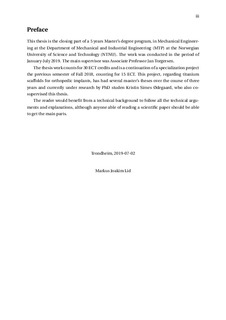| dc.contributor.advisor | Jan Torgersen | |
| dc.contributor.advisor | Kristin Sirnes Ødegaard | |
| dc.contributor.advisor | Christer Westum Elverum | |
| dc.contributor.advisor | Filippo Berto | |
| dc.contributor.author | Markus Joakim Lid | |
| dc.date.accessioned | 2019-10-18T14:06:09Z | |
| dc.date.available | 2019-10-18T14:06:09Z | |
| dc.date.issued | 2019 | |
| dc.identifier.uri | http://hdl.handle.net/11250/2623239 | |
| dc.description.abstract | Cellebaserte materialer består av sammensetninger av små bjelker og plater som tilsammen utgjør et porøst volum. Ved nøye design kan desse strukturane produserast til å oppnå spesefikke egenskaper, noe som gjør dem interessante for benimplantatsapplikasjoner. Slike cellebaserte materialer kan finjusteres til å oppnå samme stivhet som pasientens ben, noe som er foretrekket for benvekst. En spesiell klasse cellebaserte materialer, trippelt periodiske minimale overflater (TPMO), har en gjennomsnittlig krumning lik null, noe som gjør dem interessante for ben implantater. Additive tilvirkiningsmetoder, som elektronstårlesmelting (ESS), kan brukes for å produsere cellebaserte materialer av Ti-6Al-4V, som har gode biocompatible egenskaper. Deler som er laget med ESS har en høy overflateruhet og mange overflatefeil. Siden overflaten til cellebaserte materialer er så høy, vil den strukturelle integriteten og utmattingslevetiden til implantater laget med denne tilvirkningsmetoden kunne bli betydelig redusert.
Gjennom dette tesearbeidet, har modellering av TPMO strukturer blitt utforsket. Egenskaper som volumfraksjon og porestørrelse er blitt analysert slik at disse nøyaktig kan bli tilskrevet et design. Et program er laget i MATLAB, som lar brukeren designe cellebaserte TPMO strukturer med varierende volumfraksjon utfra valgte designparametre og inndata geometri. Utmattingsprøver er designet ved hjelp av dette programmet.
Et oppsett for elektrokjemisk polering er laget for overflatebehandling av ESS produserte Ti-6Al-4V komponenter. Prøver formet som små sirkulære plater er bitt laget, og behandlet med poleringsutstyret med varierede prosessparametre, og karakterisert ved elektronmikroskop. Behandlingen har gitt en glattere overflate på prøvene. Prøvene vil senere bli brukt til celledyrkingsforsøk. Resultatene fra studien vil kunne bidra til en økt forståelse av effekten overflatebehandling har på strukturell integritet og cellevekst. | |
| dc.description.abstract | Cellular materials are interconnected structures consisting of beams or shells to form a porous volume. By careful design, these complex structures can be made to obtain specific properties, which makes then interesting for bone implant applications, in such cases called scaffolds. Scaffolds can be tuned to have a stiffness which matches that of the patient's bone, which is preferable for bone regrowth. A special class of cellular materials, based on triply periodic minimal surfaces (TPMS) have zero mean curvature, which makes then interesting for bone implants. Additive Manufacturing techniques(AM), such as Electron Beam Melting (EBM), can be used to produce scaffolds in Ti-6Al-4V, which has shown to have great biocompatible properties. However, EBM manufactured Ti-6Al-4V components show many surface defects. As cellular structures have a large surface area, these surface defects could significantly reduce its structural integrity and fatigue properties.
Throughout this thesis work, TPMS scaffold modeling is investigated. Features such as volume fraction and pore size are analyzed, such that these features can be precisely described in a design. An app is made with MATLAB, which allows the user to design cellular TPMS structure with advanced volume fraction distributions, using the distance transform of an input geometry. Fatigue specimen with a TPMS structure were designed using the scripts, and produced by EBM.
An electrochemical setup for polishing of EBM manufactured Ti-6Al-4V parts was made. Specially designed plates were tested with the polishing setup for varible polishing parameters, and characterized with Scanning Electron Microscope. The plates will later be used for cell growth experiments. The results from this study could hopefully contribute to a way of modifying the surface of Ti-6Al-4V scaffolds to improve both biocompatibility and structural integrity. | |
| dc.language | eng | |
| dc.publisher | NTNU | |
| dc.title | Enhancing Bioactive and Mechanical Properties of Ti Implants Through Unit Cell and Surface Optimization | |
| dc.type | Master thesis | |
